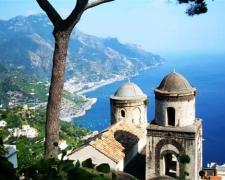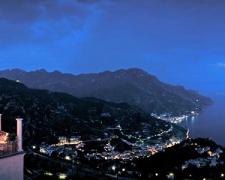Ravello Activities
Sightseeing to Villa Cimbrone
From Ravello's main piazza, head west along Via San Francesco and Via Santa Chiara to the Villa Cimbrone, a medieval-style fantasy that sits
Villa Rufolo
Directly off Ravello's main piazza is the Villa Rufolo, which—if the master storyteller Boccaccio is to be believed—was built in the 13th century by Landolfo Rufolo, whose immense fortune stemmed from trade with Moors and Saracens. Within is a scene from the earliest days of the Crusades. Norman and Arab architecture mingle in profusion in a welter of color-filled gardens so lush that composer Richard Wagner used them as his inspiration for the home of the Flower Maidens in his operaParsifal. Beyond the Arab-Sicilian cloister and the Norman tower lie the two spectacular terrace gardens, with the lower one, the "Wagner Terrace," often the site for concerts, with the orchestra perched on a precarious-looking platform constructed over the precipice.
The Duomo
The Duomo, dedicated to patron saint Pantaleone, was founded in 1086 by Orso Papiro, the town's first bishop. Rebuilt in the 12th and 17th centuries, it retains traces of medieval frescoes in the transept, an original mullioned window, a marble portal, and a three-story 13th-century bell tower playfully interwoven with mullioned windows and arches. The 12th-century bronze door has 54 embossed panels depicting Christ's life, and saints, prophets, plants, and animals, all narrating biblical lore. The nave's three aisles are divided by ancient columns, and treasures include sarcophagi from Roman times and paintings by southern Renaissance artist Andrea da Salerno. Most impressive are the two medieval pulpits: the earlier one (on your left as you face the altar), used for reading the Epistles, is inset with a mosaic scene of Jonah and the whale, symbolizing death and redemption. The more famous one opposite, used for reading the Gospels, was commissioned by Nicola Rufolo in 1272 and created by Niccolò di Bartolomeo da Foggia. It seems almost Tuscan in style, with exquisite mosaic work and bas-reliefs and six twisting columns sitting on lion pedestals. An eagle grandly tops the inlaid marble lectern.
A chapel to the left of the apse is dedicated to Saint Pantaleone, a physician who was beheaded in the 3rd century in Nicomedia. Every July 27 devout believers gather in hope of witnessing a miracle (similar to that of San Gennaro in Naples), in which the saint's blood, collected in a vial and set out on an inlaid marble altar, appears to liquefy and come to a boil; it hasn't happened in recent years. In the crypt is the Museo del Duomo, which displays treasures from about the 13th century, during the reign of Frederick II of Sicily.
The Performing Arts
Because of the role Ravello plays in the field of classical music, The Ravello Concert Society is one of the city's main attractions. The Society puts on many concerts from March through November each year. The settings for the concerts are usually outdoors in one of the many beautiful gardens that exist in Ravello.
Festivals
Ravello's program of classical music starts in March and runs through late October. The Festivale Musicale di Ravello occurs in the latter part of July. International Orchestras and special guest stars perform many pieces by Wagner. These concerts are held in the wonderful gardens of Villa Rufolo. They generally have 3-4 musical events each month in Ravello.
Walking
Ravello – Atrani - Amalfi (along Valle Del Dragone)
This walking path is considered a classic, as it was the route used by the local people before the paved road was built in 1930. On the way from Ravello to Amalfi through Atrani, you pass the ruins of a small village with its textile and olive oil mills in the valley, called Valle dl Dragone, once the industrial area of Atrani. And before entering the town of
Ravello – Atrani (through Castiglione)
Starting from Piazza Duomo take Via Trinità to the right of Villa Rufolo and follow the directions for Villa Cimbrone. After about 10 minutes walking take the stairway to the right down Via Santa Barbara. Looking across the valley you can enjoy the view from Valle del Dragone to Pontone and Torre dello Zirro. About ten minutes walk on Via Santa Barbara turn right and, follow the indications to Amalfi until you reach a paved road near a limoncello distillery. Cross the road here and follow the signs towards Atrani and walk on the steps through Castiglione.
Ravello – Amalfi (through Pontone, with detours to Torre dello Zirro and/or to Valle delle Ferriere)
The first part of this itinerary is similar to the Ravello – Atrani – Amalfi, but in this case you have to follow the directions for the main
Ravello - Minori
This itinerary begins from Piazza Duomo, heading towards Villa Rufolo. On the left of the entrance gates you will find Via Annunziata. On your right you will see the church of the Annunziata, and once past the church you come to a paved road. Crossing this you will find the second flight of steps which leads to the area of Torrello. On the way down towards the square in Torello there is a choice of two routes to Minori. You can take the wide steps of Via Santa Croce to the left, which pass under a pergola of vines and lemon trees and lead past the ruins of the
Shopping
The main
Fishing and Boating
With typical wooden coastal craft is possible to take an unforgettable mini-cruise (mornings) to discover the only fiord in the Mediterranean, but also coves, hidden beaches and many creeks and bays along the coast of Amalfi.
Boat charter-of various sizes and speed with or without skipper, for daily excursions from Amalfi to the most beautiful places on the coast (Positano, Praiano, Li Galli Isles, Nerano/Marina del Cantone, Capri,
Convent
Santa Chiara
This is a strict enclosure convent built in a magnificent position, not far away from villa Cimbrone. You can only visit the atrium and the entrance where you find the gate and the Ruota (wheel) . The gate is used for the rare contacts between the nuns and the outer world, keeping the figure hidden, and the wheel is used to pass goods in and out from the convent.
 Wedding Ceremony in Ravello
The land of poetry and passionate love affairs for a sophisticated and colorful wedding.
Wedding Ceremony in Ravello
The land of poetry and passionate love affairs for a sophisticated and colorful wedding.
 Wedding Reception in Ravello
Choosing Ravello for a wedding reception your magic day will be a real fairy tale coming true
Wedding Reception in Ravello
Choosing Ravello for a wedding reception your magic day will be a real fairy tale coming true

Social Networks